To better understand how the YouTube Search algorithm works, we looked at 3.8 million data points across 100,000 videos and 75,000 channels.
Using a keyword sample that contained a variety of named entities (people, places, things, etc.) and questions (how, why, etc.), we checked rankings for the first 20 results and fetched a wide array of data through the YouTube API, scraping, and additional analysis.
For those interested in YouTube SEO, the results should provide ample insights into the more nuanced behavior of the YouTube algorithm. While I’ll go through the essential “ranking factors” for how to rank a YouTube video and high-level correlations, some of the most exciting insights are those derived from slicing the data and comparing multiple data points. Grab some coffee; we have a lot to go through.
What Do Videos Ranking in YouTube Have in Common?
While I’m hesitant to speak of the algorithm through the lens of correlations, because they can be very misleading, they do provide a high-level starting point for exploring the YouTube ranking algorithm. All of these factors have fairly low correlation scores (which is typical of search engine ranking factor studies), so it’s best to compare the factors relatively.
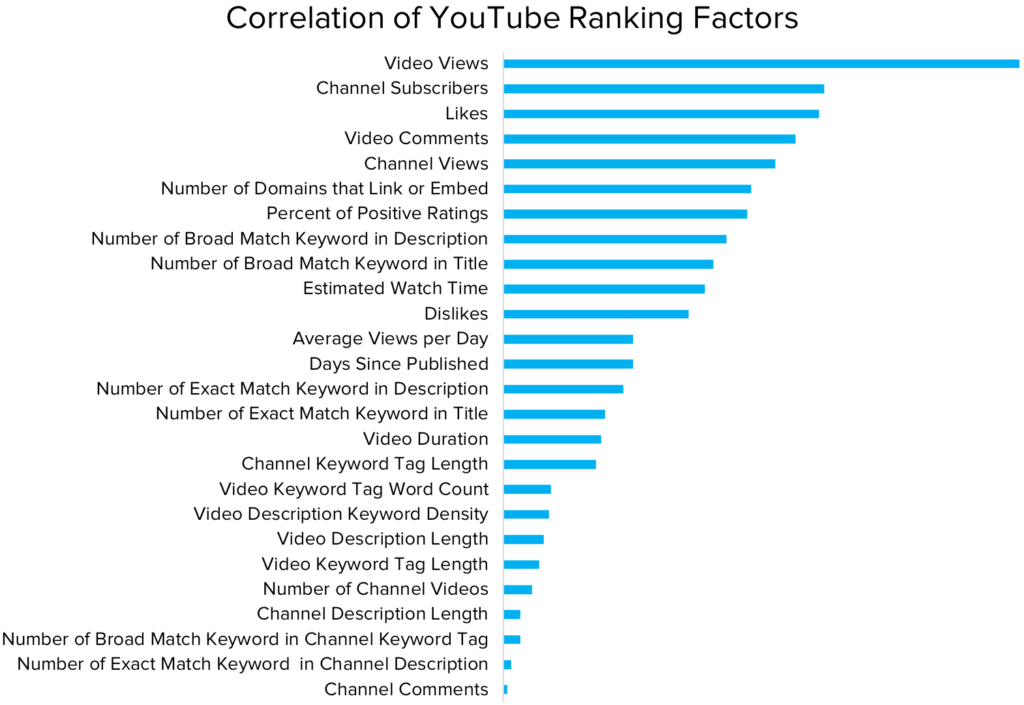
It’s also worth noting that several of these factors are “outcomes” of ranking better, so there is an obvious relationship between them. (Videos that rank well get more views than those that don’t, because searchers tend to click the top results.) Additionally, some of these are downstream “conversions” of views, such as likes, dislikes, and comments, because some percentage of people who view a video tend to engage with it. Remember here that correlation doesn’t imply causation, it’s more of a descriptor of what videos at different rank positions have in common.
Lastly, this approach looks at factors broadly and in aggregate, which hides crucial information. Several of these factors have higher or lower influence when sliced or segmented by another factor. For example, some elements have more or less weight relative to the age of a video. We also know from YouTube’s Search & Discovery team, based on its presentation at VidCon, that some factors change in weight based on the agreement of that element. (For example, if keywords in the keyword tag field are too varied and broad, the value of those keywords is reduced.) Our findings support this comment.
We found 5 negatively correlated factors, which were (from most negative to least negative):
- Likes per View
- Title Length
- Comments per View
- Number of Broad Match Keywords in Channel URL
- Number Exact Match Keywords in Channel Keywords
Those last two were nearly zero.
Common Themes
For those interested in how to rank in YouTube, we saw several consistent themes. The most important aspects of ranking well are:
- Watch time
- Channel authority
- Positive sentiment & engagement
- Broad match keyword targeting across title, description, and keyword tags
For the rest of this post, I’ll review each of the factors we analyzed in depth, provide analysis, and share some takeaways and action items based on the learnings.
YouTube Titles
Basic YouTube SEO advice is to include your keyword in your title. Our data confirm this recommendation but suggests the analysis of text-based targeting is more nuanced.
Before we get into the data, we should make a quick distinction between “exact match” and “broad match” as I defined them in my analysis.
Exact Match: An exact match was counted when the text contained the keyword precisely as a searcher typed it. If the keyword was “how many bones are in the human body,” then I counted a text element as an “exact match” if it contained that exact keyword phrase.
Broad Match: A broad match was counted when some part of the keyword appeared in the text element. As I defined it in my analysis, broad match included any non-common word from the search phrase. In the example “how many bones are in the human body,” I removed words like “how,” “are,” “in,” and “the.” The words I kept were “many,” “bones,” “human,” and “body.” I counted text as a broad match if it contained any of those four words.
Value of Keywords in Title
Let’s look at how exact match keywords perform within titles.
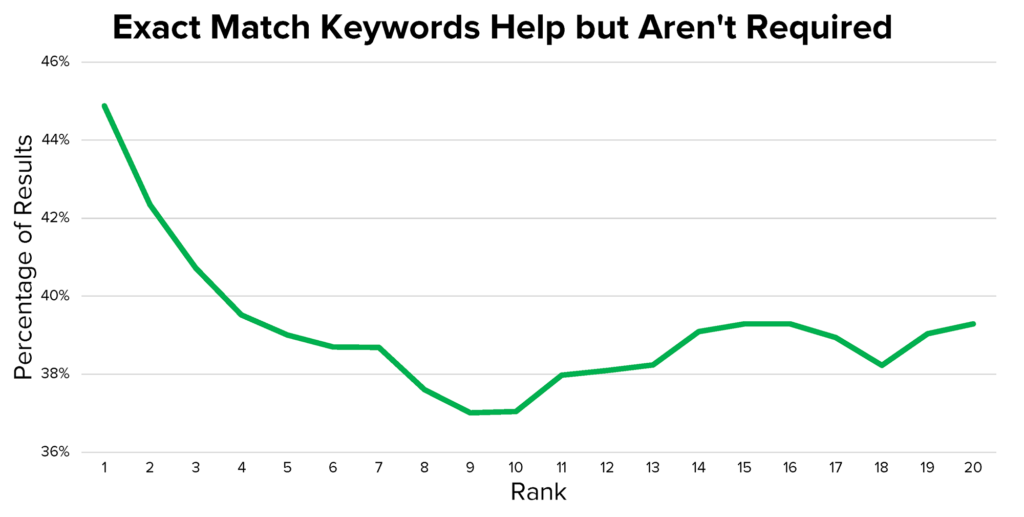
Percentage of Results Containing Exact Match Keyword in Title by Rank
There is an apparent relationship between the usage of keywords in the title and being able to rank in the top 20 results, with the top 3 to 5 results being more likely to contain the exact match keyword.
However, also note that only 38% to 45% of videos are ranking with an exact match. In other words, 55% to 62% of videos rank without using the exact match term in the title. YouTube can do a more sophisticated analysis of text, including broad match, synonyms, related words, typos, and stemming (ing, ed, etc.), which can determine relevance without the exact match mention.
However, some level of YouTube keyword usage is essential, as we see when we look at broad match:
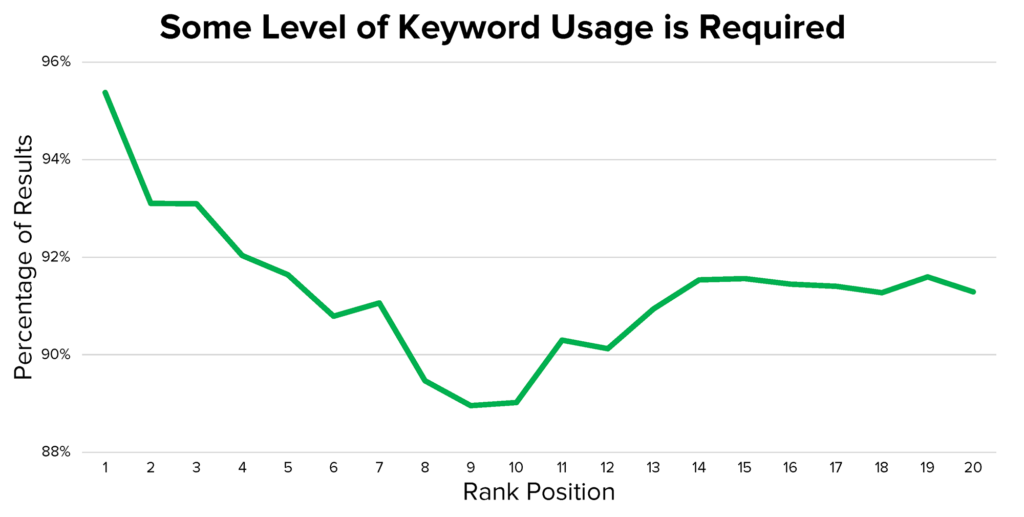
Percentage of Results Containing Broad Match Keyword in Title by Rank
Here we see the same positive relationship between keyword usage and rank position. However, we see a substantially higher number of results (> 90%) included at least part of the keyword in their title.
In short, if you want to rank, you almost always need to have some part of the keyword phrase in the title.
How Title Length Influences Performance
This doesn’t mean that you should stuff your titles with keywords. An analysis of title length suggests that longer titles underperform.
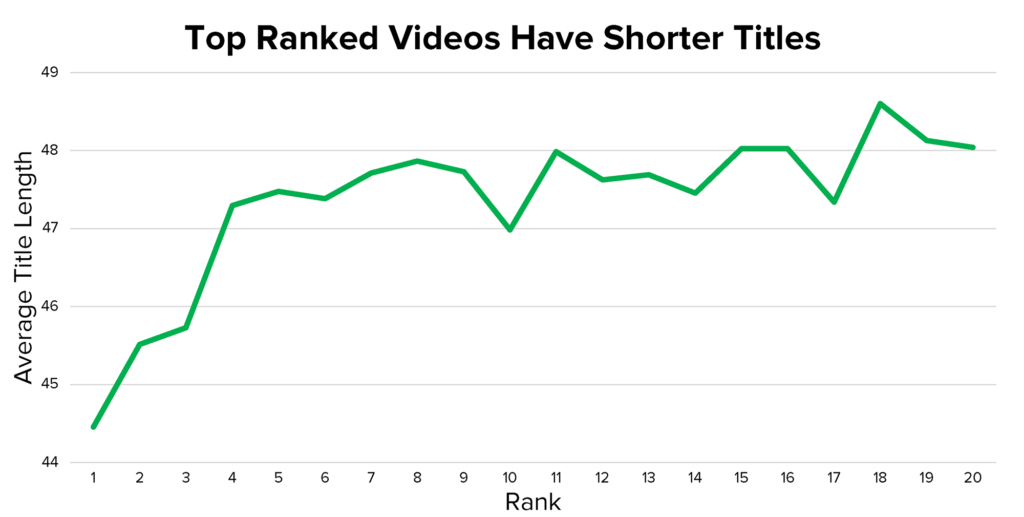
Most titles on videos ranking in the top 20 positions average around 47-48 characters, with the highest ranking YouTube videos having the shortest titles.
There appears to be a relationship between title length and ranking performance.
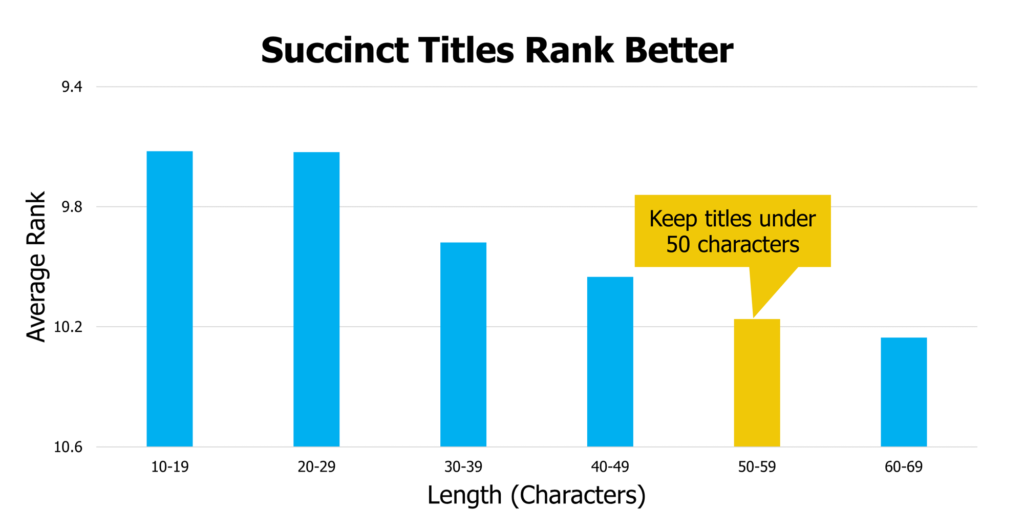
Shorter titles tend to perform best, with performance getting incrementally worse beyond 50+ characters. This relationship suggests that succinct video titles tend to outperform more extended and cumbersome titles.
I don’t think title length is a direct factor. However, I do believe a long title corresponds to a couple of issues that might be related to lower performance.
Videos with longer titles might:
- Be more likely to have keywords stuffed in them.
- Be less focused on a central concept.
- Have lower CTRs and get fewer views (and watch time).
Takeaways
- Use your keyword in your title.
- If you can’t use your full keyword in your title, use some words from it.
- Strive to keep titles under 50 characters.
- Titles between 20 and 40 characters seem to be a sweet spot.
- Be succinct and focused on your primary topic.
YouTube Descriptions
We see a similar relationship with YouTube video descriptions, but they appear to be less impactful or at least used less frequently to target keywords.
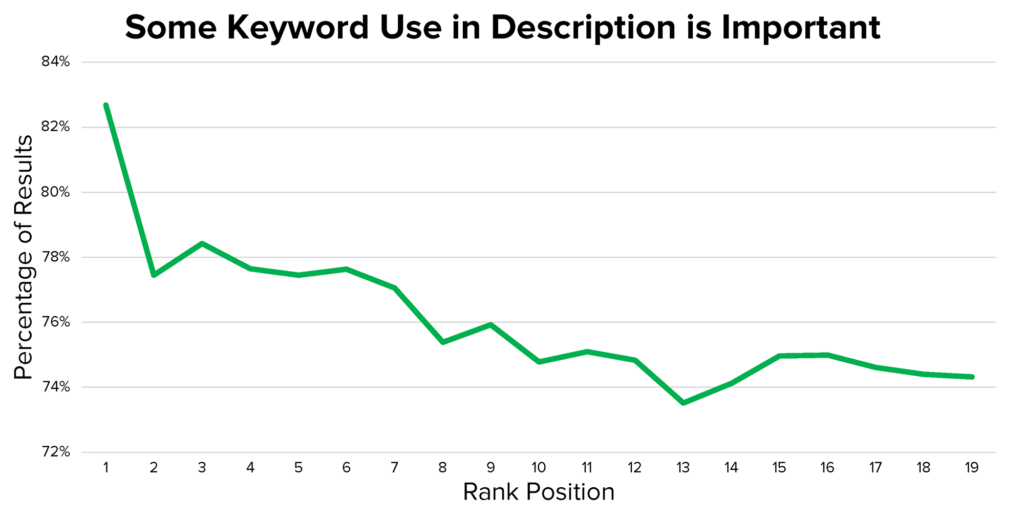
Percentage of Results Containing Broad Match Keyword in Description by Rank
There is a positive relationship between broad match keyword usage in descriptions and ranking. However, with only 75% of top 20 results using some broad match variant in their description text, it’s not as essential as including your keyword in your title but still highly recommended.
Keyword Density
To explore this relationship further, we used the basic concept of keyword density.
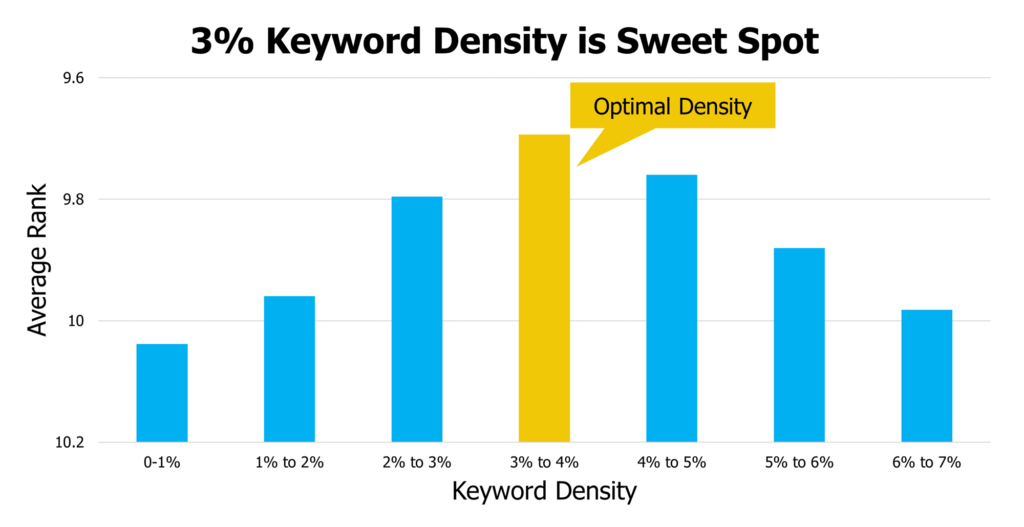
We see a 3% to 4% keyword density as being the sweet spot for keyword usage in the description. Keyword density can help account for variable description lengths, providing slightly more sophisticated guidance than “repeat the keyword X times.”
Keyword density in the description is calculated using the following formula:
Description Density = (# of Broad Match KW Phrase Mentions) x (Number Words in Keyword Phrase / Words in Description) x 100
Based on the calculation of keyword density, the number of times you should mention your keyword varies based both on the length of your description and how many distinct words are in your keyword phrase
For the longer lengths, those mentions can seem quite high, so be careful to not “keyword stuff.” The way to get higher mention counts is to use various phrases that include parts of your keyword. In other words, use your secondary keywords, include longer phrases associated with your keyword, and use variations of related phrases. Above all else, make sure you’re writing naturally.
Limit Description Length
I’d caution against aggressively using the description, as that can seem to hurt performance. Take a look at how word count impacts rankings.
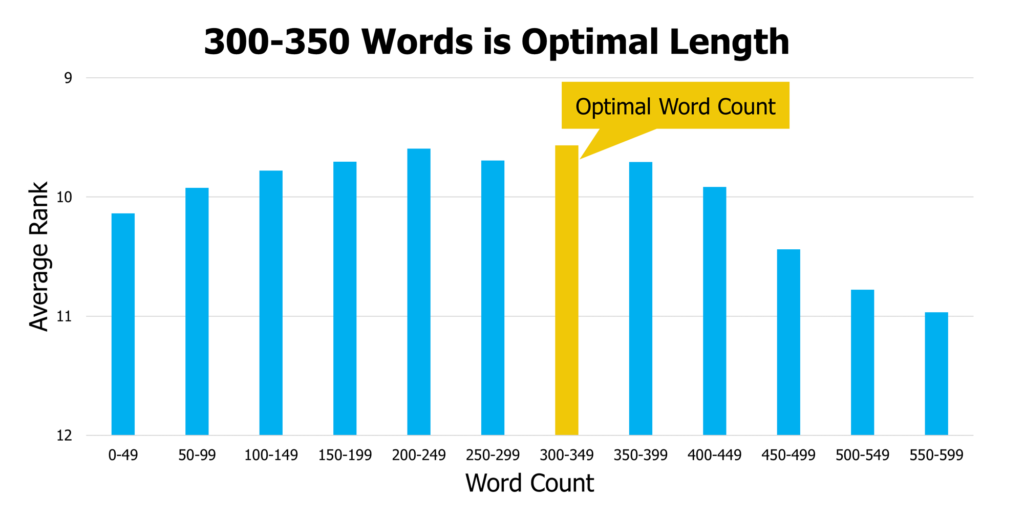
A lengthy and more robust description is advantageous, but only to a point. The sweet spot seems to be between 200 and 350 words. Beyond 350 words, average rank performs worse on average.
I don’t think description word count is a direct ranking factor but is more suggestive of other issues.
Longer descriptions are:
- More likely to keyword stuff and use other abusive behavior.
- More likely to include off-topic content, and, as a result, may not be tightly focused on a single subject.
- More likely to have a wide array of affiliate links.
- More likely to have a robust set of non-relevant information (i.e., too much social, CTA, broad “about us” information, and sales copy).
This trend also holds true for view performance.
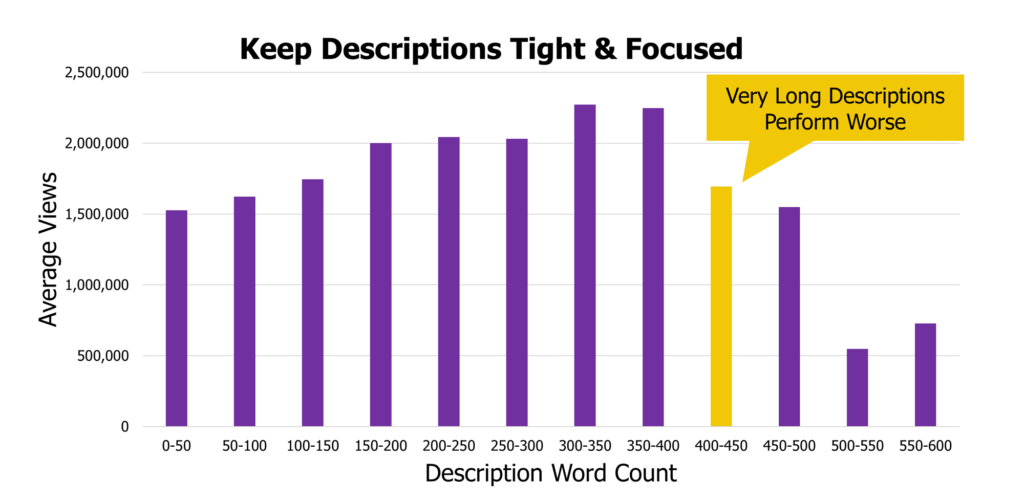
When looking at view performance, we see a sweet spot around 350-400 words.
In aggregate, this can give us some reasonably clear guidance on how to most efficiently use our video’s description.
How to Optimize YouTube Descriptions
A formula that I’ve seen work well is:
- Brief CTA for a relevant next video to drive session length and related videos.
- Subscribe CTA to help build your distribution power.
- 50 to 150 words in the description to summarize and describe your video, mentioning a broad match variation of your keyword 1 to 3 times, depending on length.
- List additional videos to watch, focused on your best content about the same or a similar subject matter as this video, creating recommendation clusters.
- A brief bio and/or list of social accounts, which can help build your distribution power.
- Avoid exceeding 400 words without a good reason to do so, because stuffing or going broadly off topic can harm performance.
Takeaways
- Use target keyword, or at least a broad match variation, in your description.
- Aim for a 2% to 3% keyword density by using variations.
- Aim for around 300 to 400 words.
- Keep description tightly focused on the video’s subject.
YouTube Keyword Tags
Our analysis on keyword tags surfaced some fascinating insights, which support the YouTube Search & Discovery team’s claim that the influence of this factor is variable based on different factors, such as how closely the tags agree with each other on a subject matter.
While I’m only showing this behavior relative to keyword tags, these trends and themes seem to hold true for keyword targeting benefits, in general.
Keyword Usage
First, let’s look at broad match keyword usage in the keyword tag field.
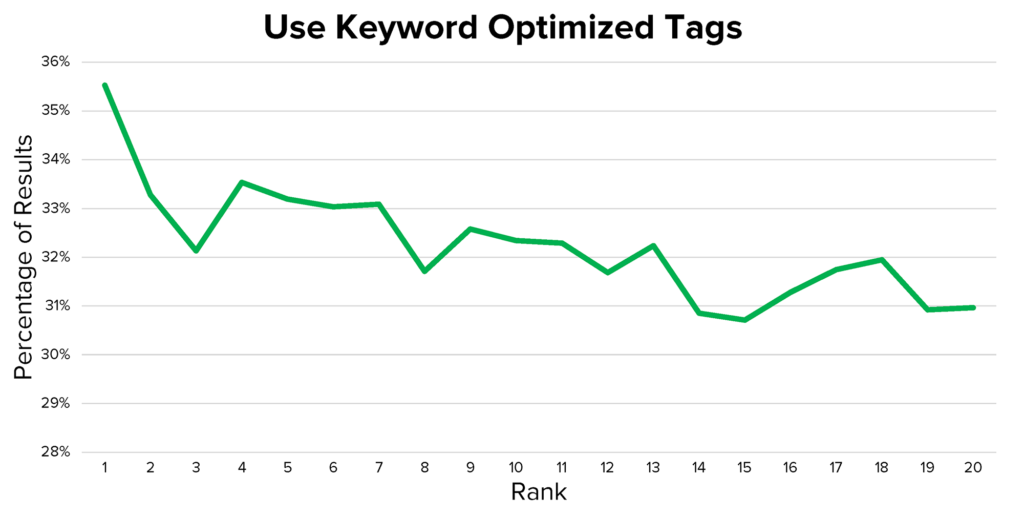
Percentage of Results Containing Broad Match Keyword Tag by Rank
Similar to other text-based factors, we see a positive relationship between keyword usage and rank position. However, only a third of videos in the top results use the keyword in their tags. This usage rate may imply that keyword tags are less critical than titles and descriptions, or are at least used less effectively.
Having read several YouTube research papers, I think this is, in part, due to YouTube’s ability to infer implicit keyword tags based on related terms and by looking at the words used by associated videos. For example, they know that “skeleton” is related to “bones,” so the inclusion of one of those terms helps them know you’re relevant for the other term. YouTube can infer this without the creator explicitly defining it. Additionally, if a video has no keyword tags, but is frequently watched in a relationship with (called “cowatch”) a video about “human bones,” they could then infer that the video without tags might be about “human bones” as well. The combination of these two techniques allows them to fill a lot of gaps in a video’s subject matter over time.
Keyword Tag Length
Keyword tag length and “focus” appear to have similar effects as descriptions.
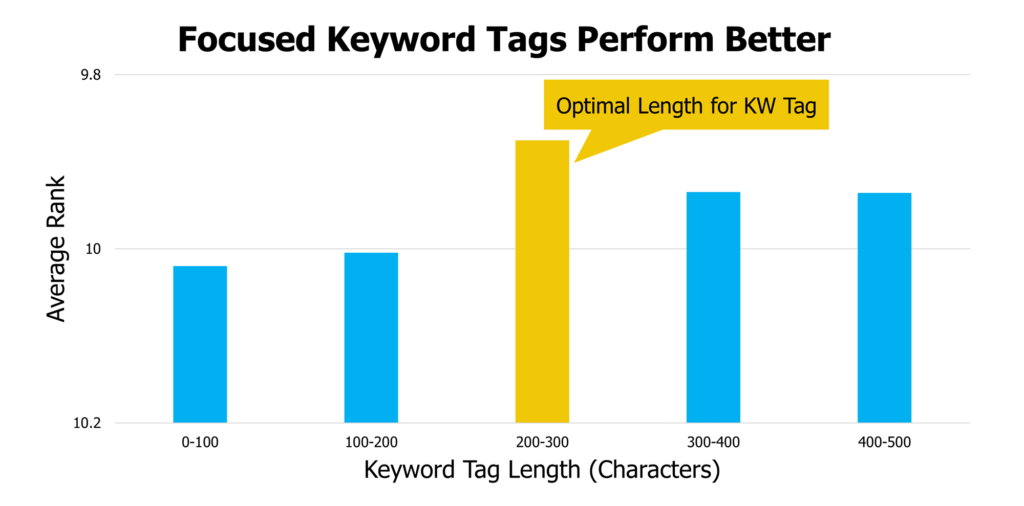
We see a sweet spot around 200 to 300 characters. Again, I don’t think this is a direct factor but is suggestive of optimization issues associated with more prolonged keyword tag fields (off topic terms, keyword stuffing, etc.)
However, we see something a little different when we look at views, which may be suggestive of related video performance via the recommendation algorithm.
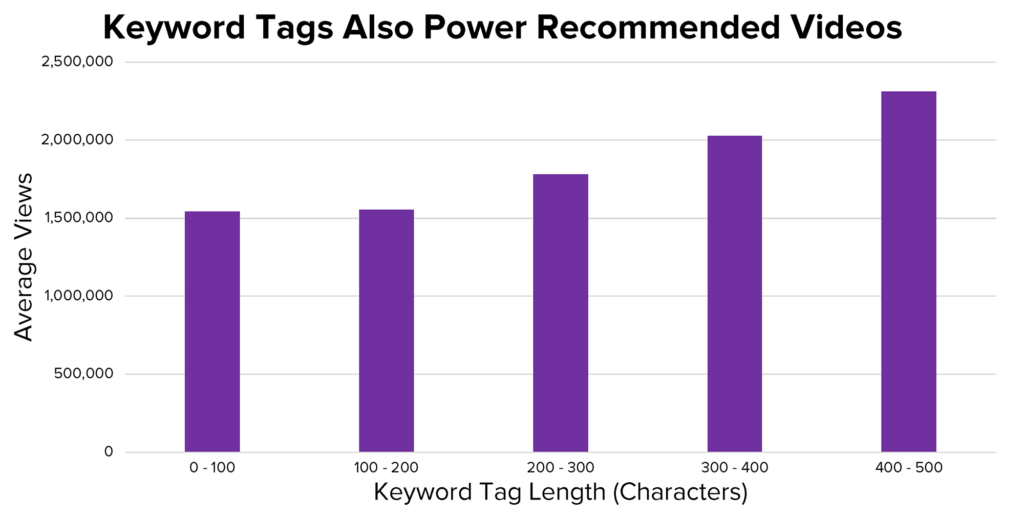
It seems that the more data you give YouTube in the keyword tag field, the better a video performs.
However, YouTube seems to prefer 2-4 word phrases over many single word phrases when we compare this to the optimal number of unique tags used to achieve the character count.
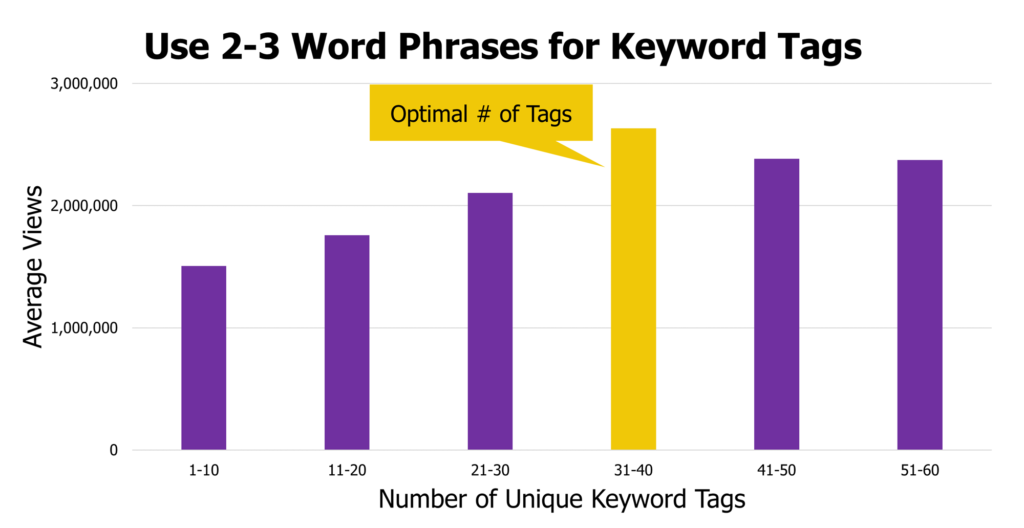
Tag performance is highest between 31 and 40 distinct tags, which may suggest it’s better to target multiple moderate-length keywords than it is to use very short or very long keyword phrases.
For example, it’s better to target “how many bones in human body, bones in finger, bones in body, 206 bones”, than to target “human, bones, body, 206” or “how many bones in human body, how many bones do humans have, how many bones does an adult human have.”
Don’t forget that keyword tags influence “Suggested Videos” in addition to search, so use them to influence video suggestions, as well.
Takeaways
- Include broad match variations of your keyword.
- Use as much of the character limit as you can without losing relevance.
- Scrutinize every keyword if you exceed 300 characters.
- Keep keyword tags tightly focused around the topic.
- Use moderate-length keyword phrases as tags.
YouTube Keyword Tags Over Time
The value of the keyword tag is not always consistent. We see its impact changing based on the age of a video. The keyword tag field is less helpful in improving rankings the older a video gets.
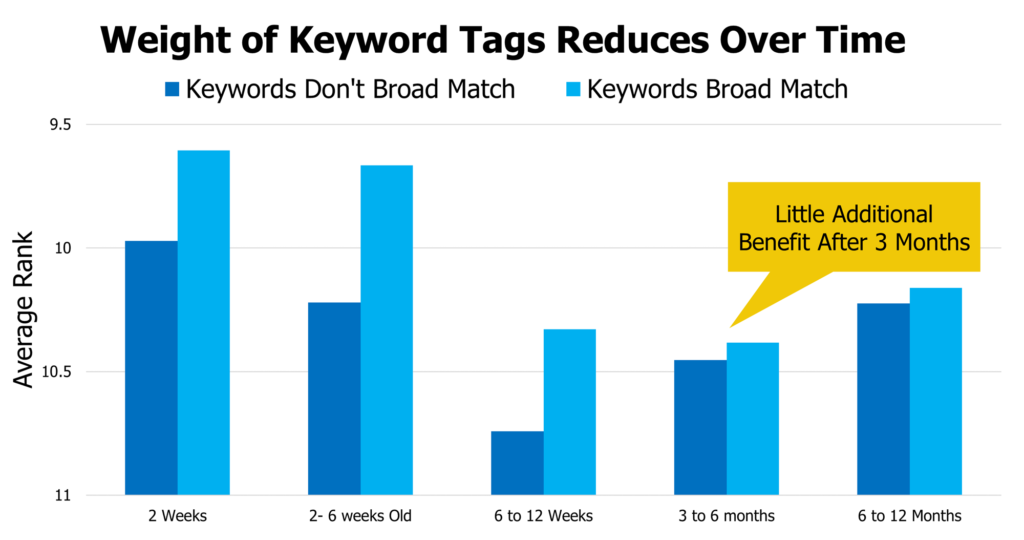
We see keywords providing a noticeable ranking boost within the first three months of a video’s life, but that increase becomes marginal after three months. This variance is a crucial insight to have.
My theory on why this happens is that YouTube is more reliant on creator contributed video data early on, when it has fewer usage data points to make a determination on what a video is about. As a result, creator-defined data is given more weight, and YouTube must rely on it during the first few months of a video’s lifespan. However, once it has sufficient view data, cowatch data, watch time, CTR, and keyword specific watch time data (how many minutes watched by users who clicked on it from SERPs for a particular keyword), YouTube can be much more confident about the video’s subject and where it’ll perform best.
This behavior means keyword tags are critical for your launch and early stages of video promotion. However, as your video ages, it is essential to focus on distribution, promotion, and cowatch optimization, as usage data overtakes keyword data over time.
This variance over time also helps highlight the unusually high value of using keywords to target trending topics that either have high demand and search velocity, such as a current event, news, or piggybacking off a trending video.
Takeaways
- Use keywords to create initial visibility on your most valuable keywords.
- Find relevant videos you’d like to appear next to as “Suggested,” analyze their tags, and use those keywords for early “related video” visibility.
- Be diligent about keyword tags for keywords that rank “fresh” (recently published) content, such as news and trending topics.
YouTube Channel Keyword Tags
In addition to setting keywords for a video, a YouTube channel can use keywords specific to the broad subjects of the channel.
Here is what we see when we looked at broad match keyword usage in the channel keywords.
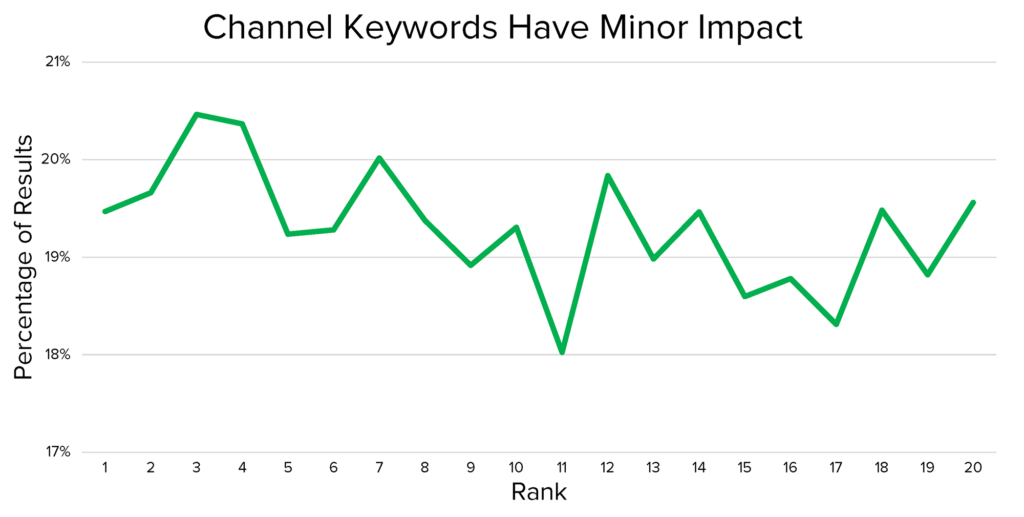
Percentage of Results Containing Broad Match Channel Keyword by Rank
In general, we see a minor positive relationship between keyword usage in the channel keyword field and rank performance. In aggregate, we found this factor to have a negative correlation. Looking through the data, I observed that this field was often left unused, leveraged poorly, or abused by stuffing with keywords.
However, we do see incremental improvements when channels use a handful of keywords here.
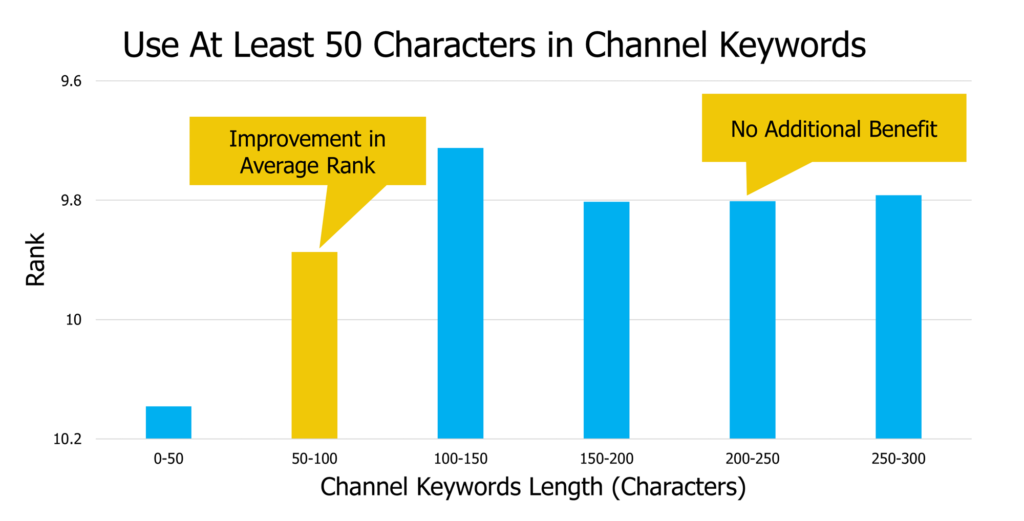
We saw improvements in average rankings for channels with over 50 characters in their channel keywords, but this marginal benefit fell off quickly as channel keywords increased in length.
This relationship suggests there is a minor benefit if you use a few essential broad match terms, but overdoing it can negate the vale. The value may also function much like video keywords, where topical nearness, usage data, and abusive behavior can shift the impact.
Takeaways
- Identify 5 to 15 keywords that describe broad subjects you cover.
- Focus on including keywords that often repeat in many of your target keywords.
- Keep them under 100-150 characters.
YouTube Channel Description
Additionally, we explored broad match keyword usage in a YouTube channel’s description.
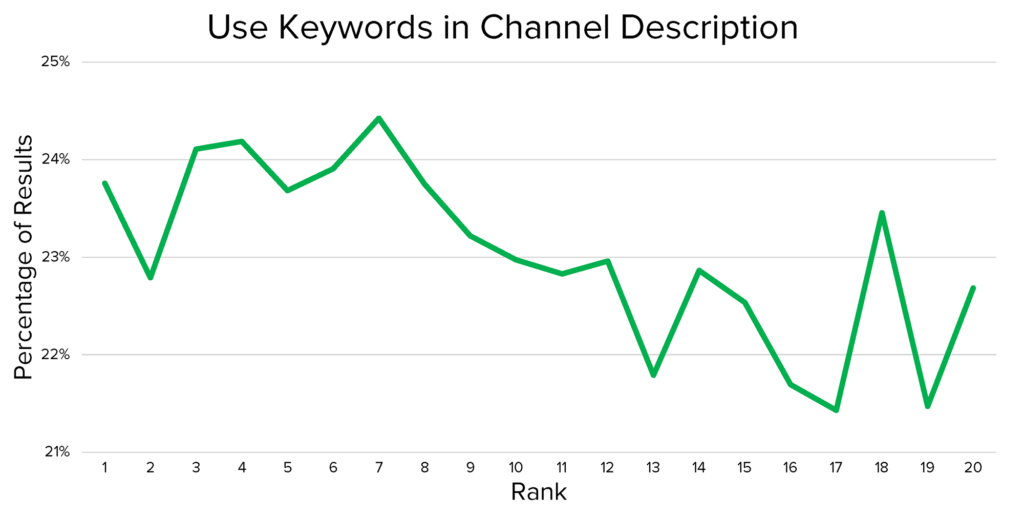
Percentage of Results Containing Broad Match Keyword in Channel Description by Rank
We see a slightly more apparent positive relationship than the channel keyword tags. Including some of the broad, commonly used keywords within your niche within in your channel description may provide a slight edge in rankings.
However, there appears to be a minimum amount of content needed to get the benefit.
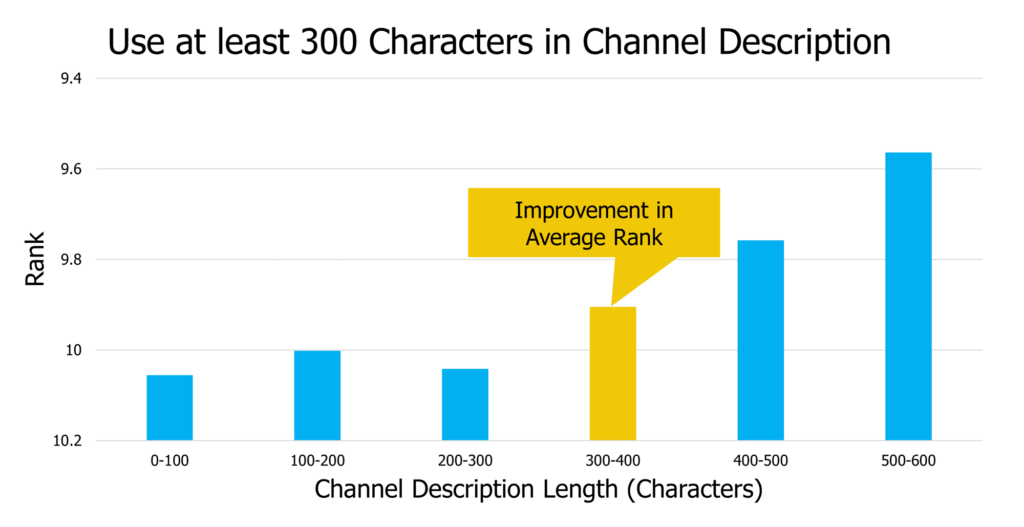
After about 300 characters, average rank performance begins to improve. This improvement point provides a useful minimum length when optimizing a channel’s description.
Takeaways
- Use at least 40-50 words of content within your description.
- Identify 2-5 keywords that describe broad subjects you cover.
- Focus on including keywords that often repeat in many of your target keywords.
YouTube Channel URL & Name
An often under-considered area of optimization is a channel’s custom URL and the channel name. These seem to have a small benefit, like “exact match domains” do in traditional SEO, although the weight appears minor.
Here is the visibility of videos with broad match keyword in the channel URL.
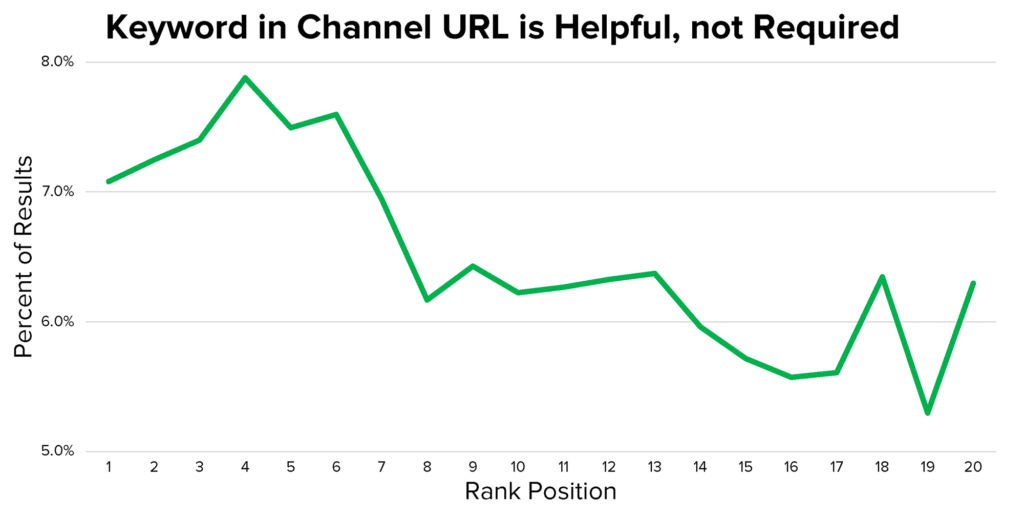
Percentage of Results Containing Broad Match Keyword in Channel URL by Rank
If the subject area of your channel is tightly focused, it may be beneficial to name your channel something that aligns to top keywords in the space. This tactic takes advantage of YouTube’s need to manage multiple searcher intents, including a navigational intent. It’s hard for them to be entirely sure if a user just wants videos on a subject or videos from a specific channel.
If you want to rank well for all things related to Star War Theories, naming your channel “Star War Theory” or “Star Wars Explained” can’t hurt.
However, while there appears to be a positive relationship between matching name / URL to keywords, only a tiny percentage of results are these type of matches. It’s definitely not necessary, but it could give you a slight edge if you’re very focused on a subject.
Takeaways:
- For channels focused on a distinct topic, using a channel name and custom URL that includes a primary keyword can give a slight edge.
YouTube Views
Looking at views as a “ranking factor” has complications because it’s also an outcome of ranking in YouTube search. However, we do see a strong relationship between views and rank position.
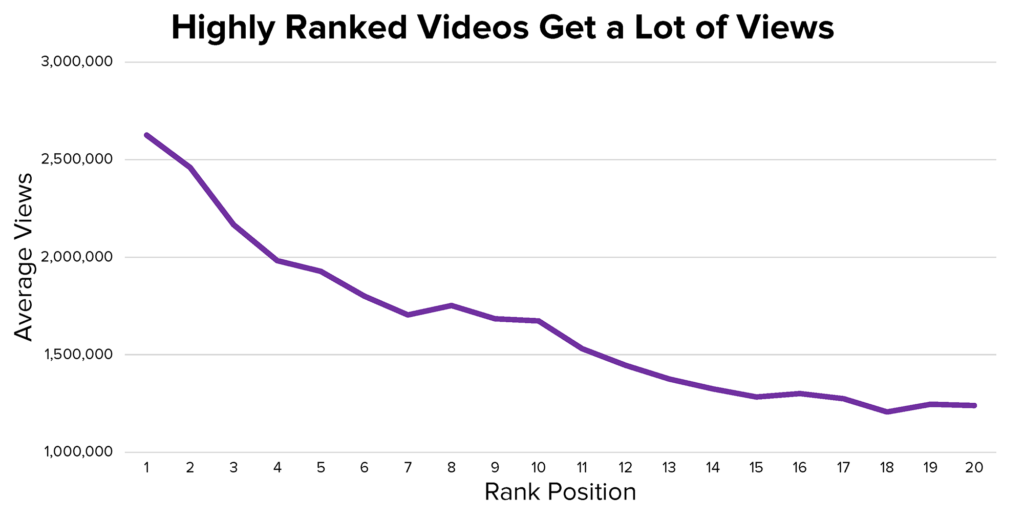
Keep in mind that this is a much a click-through-curve as it is an evaluation of a “ranking factor.”
Observations:
- Sharp decline between positions #1 and position #3
- Strong decline between positions #3 and #7
- Relatively flat performance between positions #7 and #10
- Dip between Positions #10 and #11
- Relatively flat between positions #18 and #20
This behavior is similar to what we see in traditional Google SEO CTR curves. The winners take most, with a steady decline in clicks as you move down the results. Most users are significantly less likely to look at deep results.
Whether looked at as an input or an output, there is no denying that videos with lots of views perform well in YouTube Search. This relationship is no surprise considering YouTube’s openness about the value of watch time, which is downstream from a video view.
Takeaways
- Views are one of the primary factors of success within YouTube’s search.
- Focus on distribution efforts including PR, social, email, paid, and outreach that drive traffic into YouTube.
- Focus on cowatch video strategies, such as tags, playlists, CTA, and publication sequencing, as this feature drives a significant percentage of traffic to videos.
- Invest in promotion strategies that encourage embeds on sites with strong existing audiences and traffic.
- Have a website where you embed your video, which can acquire additional traffic through traditional organic search (traditional SEO), as embedded views carry the same weight as in-app views, but tend to have lower session durations than sending traffic to YouTube.
- Focus on growing subscriptions, as they’re a useful distribution list for your videos.
YouTube Watch Time
To look at watch time, I created a simple algorithm to estimate a potential watch time.
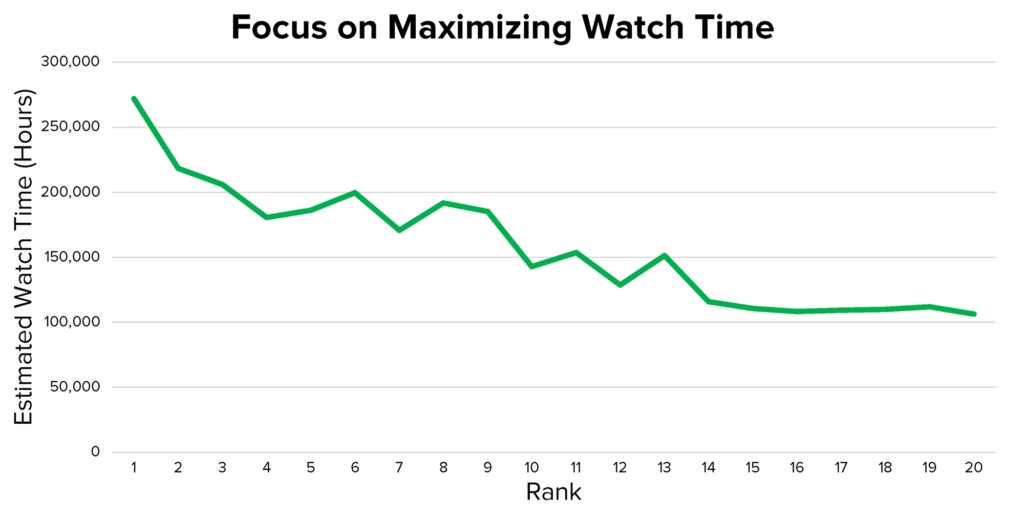
Estimated Watch Time = Views X Duration X Retention Rate X Percent of Positive Reviews
- Views: Number of times a video was viewed
- Duration: Time length of video
- Retention Rate: A retention rate curve that varied based on the video’s length, which caused duration to be less impactful the more prolonged the video was.
- Percentage of Positive Reviews: Likes divided by Likes + Dislikes
This estimated value isn’t a perfect science, but it ended up being one of the more correlated metrics.
Takeaways
- Focus on maximizing watch time by improving retention.
- Publish longer videos to maximize watch time.
- Develop a core group of highly engaged fans.
- Align video content with the topic keyword to maximize keyword-specific watch time.
YouTube Ratings (Likes & Dislikes)
While YouTube has historically placed significant weight on watch time, their focus appears to be shifting more towards “satisfaction,” which can be measured in some sophisticated ways, using data I cannot access. However, I tried to look at satisfaction broadly by calculating what percentage of total ratings (Likes + Dislikes) were positive (Likes).
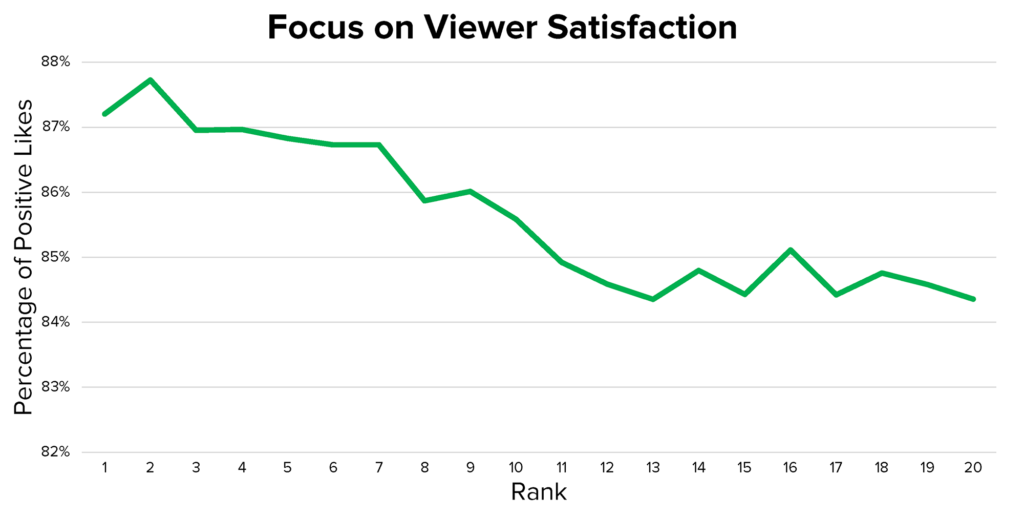
We see a positive relationship between positive review sentiment and performance. In particular, it seems that videos within the top 10 are more “stand out” than those beyond position 10, where the curve flattens out.
It’s worth clarifying that this is a ratio and not a measure of raw likes. Likes and dislikes are effectively a conversion event based on a view event (some percent of viewers click like or dislike), so like the View by Rankings chart, it has an apparent correlation. However, that’s in part because Likes are as much an output as they are an input.
It’s not a matter of driving a high number of likes, but ensuring the vast majority of Likes or Dislikes you received are positive.
However, we do see this engagement conversion rate fall off amongst the most popular videos.
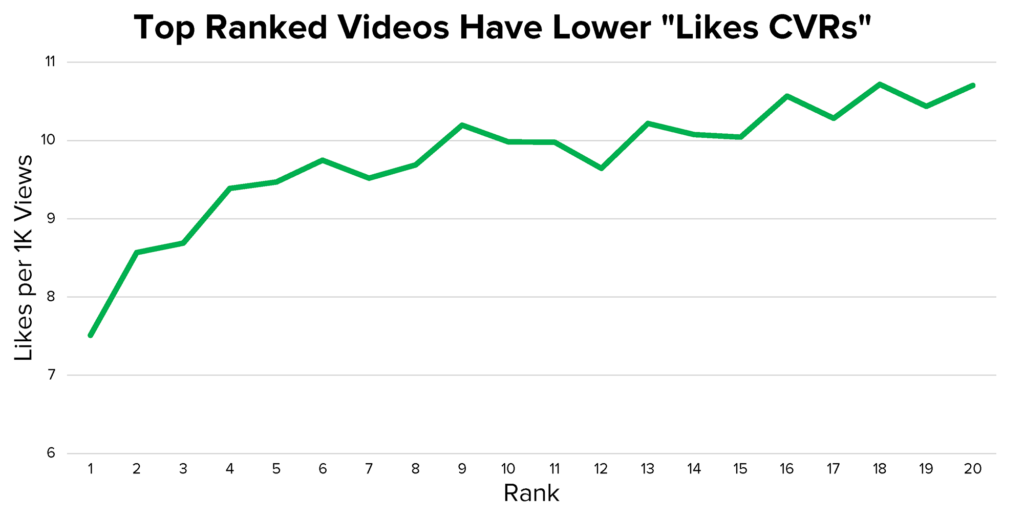
In general, the more visibility and traffic a video gets, the harder it can be to convert a view into an engagement. There are a few possible explanations for this trend. It’s possible that highly visible videos are more likely to be surfaced to broad non-YouTube Community viewers, who may be less likely to interact on the platform. Additionally, viewers might watch popular videos, such as trailers and music videos, multiple times, but they can only “like” the video once.
Takeaways
- Aim for a like-to-dislike ratio higher than 5.5.
- Think of likes as a confirmation of satisfaction, and use this metric to learn about your audience’s preferences.
- Likes aren’t qualitative, so look to comments, social media, and surveys of your community to learn about audience sentiment, wants, and needs.
- Adjust strategy over time based on the learnings of this analysis.
YouTube Video Duration
Duration, or how long a YouTube video is, has several fascinating interactions with rank performance and viewer behavior. A lot of creators struggle with how long they should make a video, and this data helps answer that. However, keep in mind that this information is unique to the YouTube platform and should not be used as guidance for other types of video (Facebook, Instagram, product videos, educational videos on your site, etc.)
What Length Do Viewers Prefer?
In short, viewers tend to like longer, but not too long, videos.

The videos that are most effective at converting views into likes are those between 10 and 16 minutes long. Videos less than 5 minutes long tend to get a lower percentage of positive reviews, and videos longer than 16 minutes start to see a decline in engagement conversion.
This trend seems to be, in part, due to users’ relative affinity to videos of particular lengths. Short videos are typically very poorly rated.
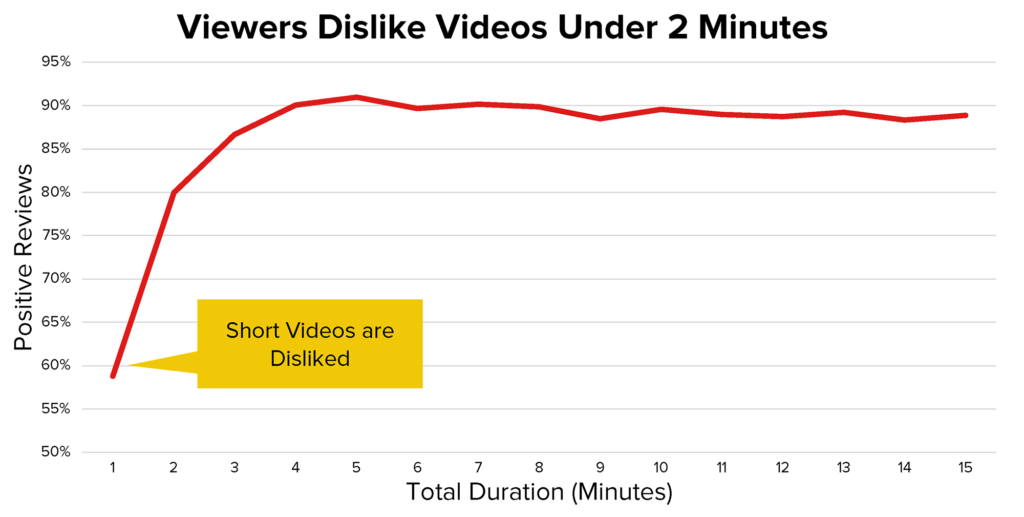
In general, videos less than a minute do very, very poorly concerning positive reviews. Positive sentiment improves with every minute up until about 4 minutes, where it evens out. This behavioral trend helps demonstrate the difference between YouTube audiences and those on other platforms, where short videos may perform better.
How Length Influence Rankings
The algorithm seems to follow the users on this one as well.
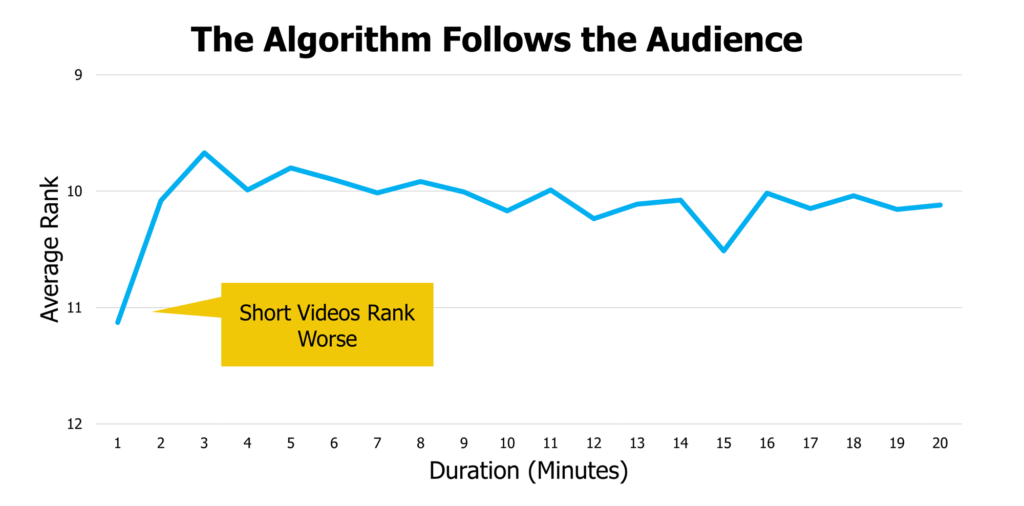
The algorithm appears to rank videos less than 2 minutes notably worse, but this evens out after about 4 minutes (perhaps this aligns with their “Short” duration search filter of 4 minutes).
How Duration Affects Views
Duration has an impact on a video’s ability to drive views and the subsequent watch time.
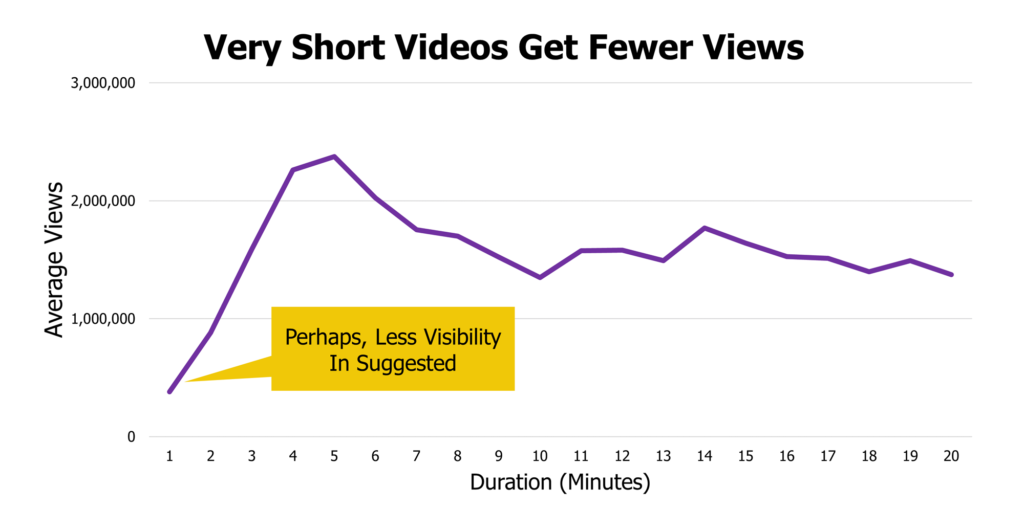
For those looking to perform well on YouTube, strive for videos that are at least 4 minutes in duration.
If we dig in deeper, by looking at a continuous best-fit curve, we can find a bit of a sweet spot. Views by duration appear to peak around 4:26 in length. That is to say, videos around 4.5 minutes tend to accumulate the most views, on average.
However, performance within YouTube search is not all about view counts but watch time. This relationship and relative retention fall off curve interact with watch time.
I compared my estimated watch time value to a video’s duration and it illustrates an important point.
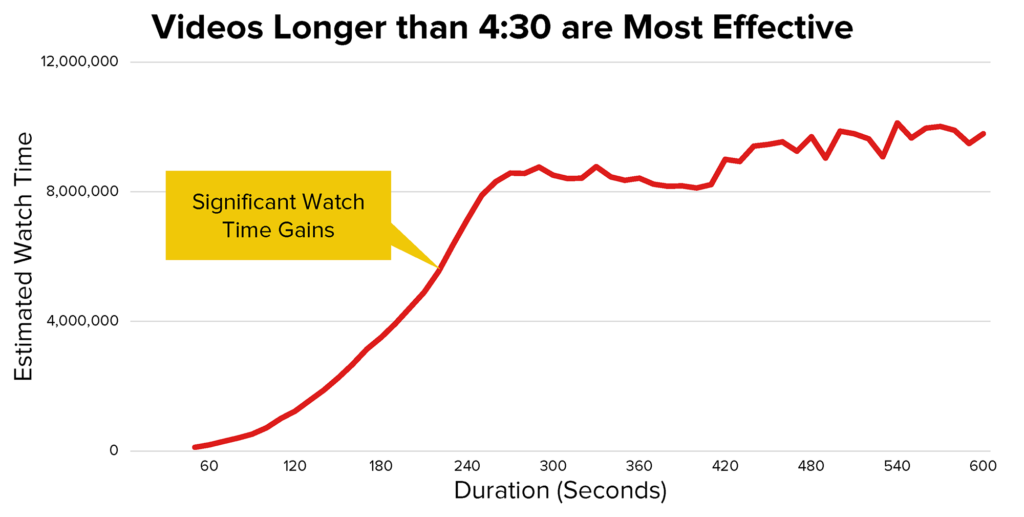
A video’s duration is a useful tool for driving incremental watch time up until about 4.5 minutes, at which time you hit diminishing returns. In other words, every extra second up until 4.5 minutes helps a lot, but after 4.5 minutes, it helps a little.
However, it doesn’t decline. It continues to rise, so if you’re trying to maximize watch time, do not shy away from 10+ minute videos. Also, there is no decline in sentiment, rank, or views for videos beyond 10 minutes.
This point is vital, because watch time is a significant ranking factor. While there is a retention curve associated with video duration which describes how users typically “fall off” throughout a video, longer videos can drive incremental watch time, even if they become less efficient at doing this with each additional minute.
In simple terms, a 5-minute video might get more views than a 10-minute video, but the 10-minute video is more likely to accumulate a substantial amount of watch time to make up for that. In our data, 10-minute videos had about 15% more watch time than those that were 5 minutes.
We see 10+ minute videos performing well in search.
How Long are Videos That Rank Well?
The longer a video is, the better it tends to perform.
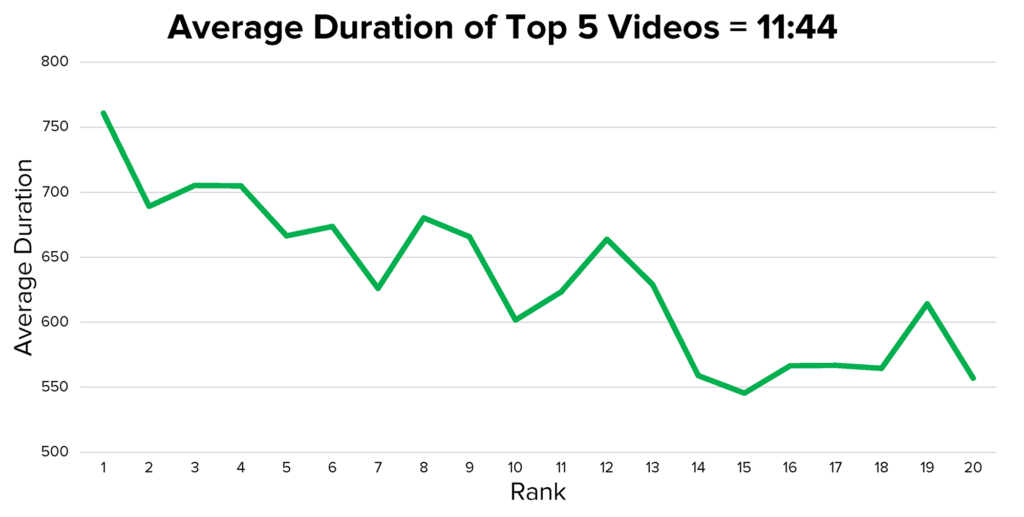
The average duration of videos that rank in the top 5 is 11 minutes and 44 seconds, and there appears to be a positive relationship between video length and rank performance.
Takeaways
- Avoid videos less than 2 minutes in length.
- Aim for at least 4.5 minutes in length, as you don’t want to waste the efficient watch time benefit up until that duration.
- Consider creating videos that are 10+ minutes in length to maximize watch time, especially if you can produce them efficiently.
- Anticipate diminishing returns in performance after 16 minutes.
Age of Video
The lifetime age (number of days since publication date) of a video appears to have some interesting interactions with search performance.
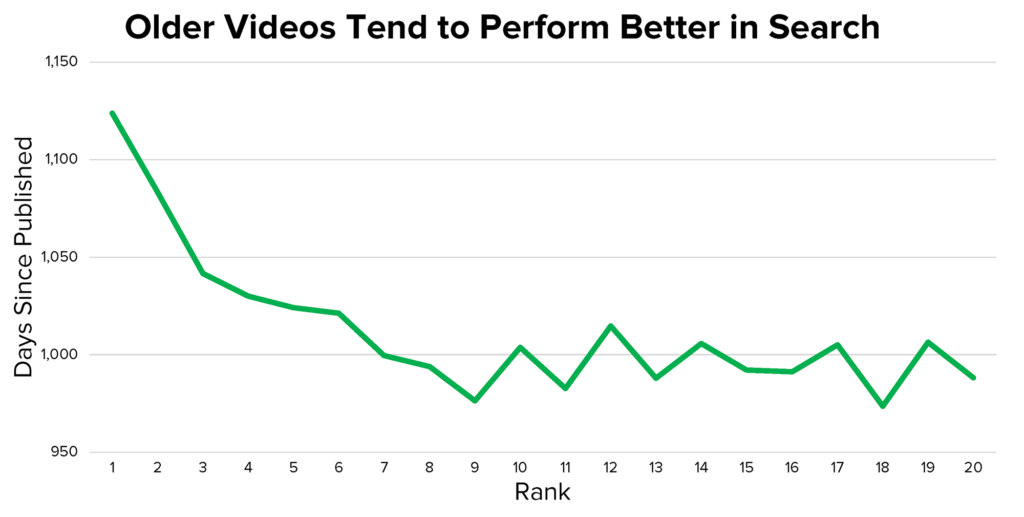
There is a positive relationship between age and rank performance, with videos in the top 2 results being notably older on average. This chart is a bit misleading, though, which we’ll explore more in a moment.
My theory on why we see this relationship is that older videos can accumulate more watch time than median age videos. However, I suspect they have a time-restrained approach of looking at results to prevent staleness.
Fresh Content Boost
While older videos tend to perform best, on average, new videos appear to get a short-term ranking boost during the first few weeks of their lifespans.
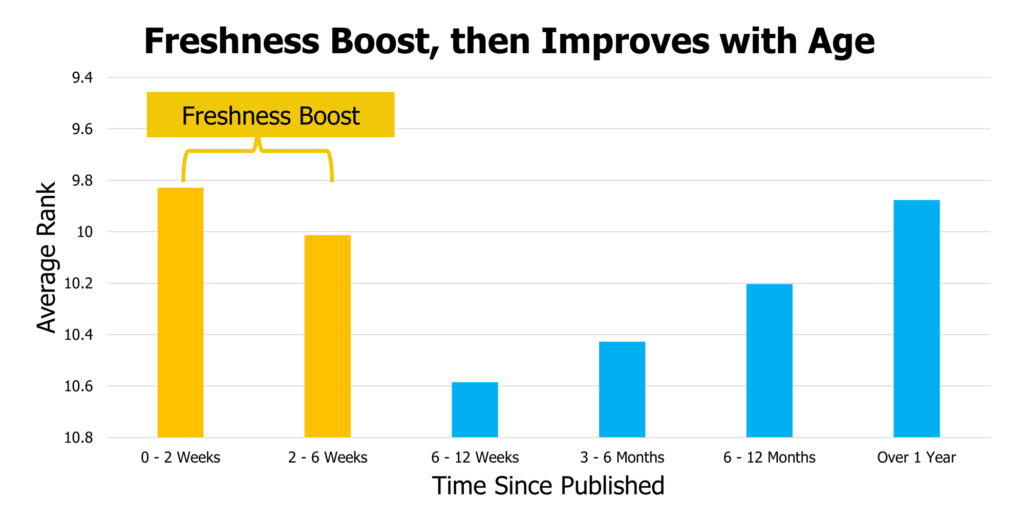
We see fresh content, published in the last two weeks, generally performing the best. This ranking boost decays over a period of 6 weeks, at which time videos tend to rank the worst in search results. From this point on, those videos start to perform better as they age (and collect watch time and usage signals).
To understand this more, I drilled into the first 12 weeks of a video’s life.
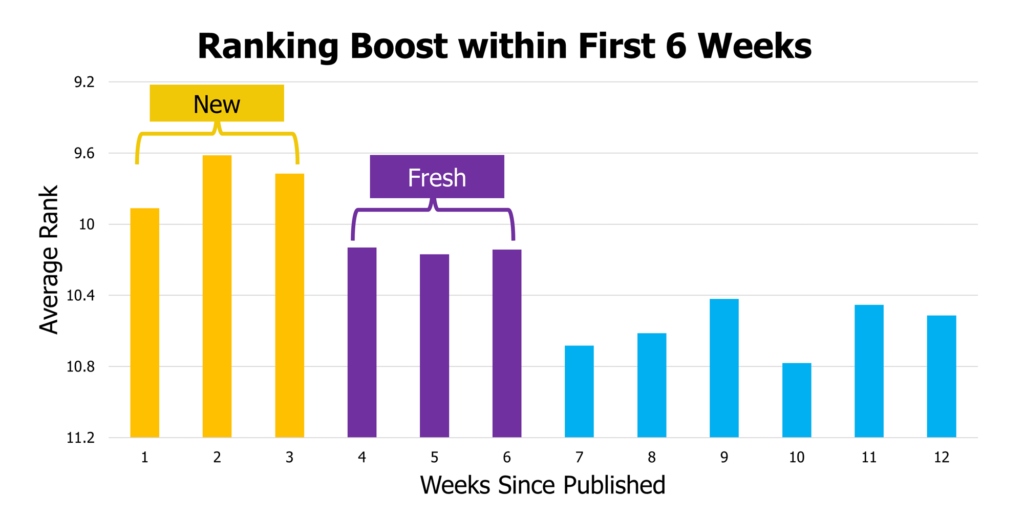
Here we see two distinct phases: the first three weeks (1-3) and the second three weeks (4-6). The graph seems to highlight two different phases of a freshness boost that have a stepwise reduction twice during the first seven weeks.
This behavior, along with things like the time-based variance of keyword tag weight, demonstrates one reason why correlations can hide some truths. Video age corresponds with improved rankings, but brand new videos can rank incredibly well.
However, this may not be the result of age being a direct input. It’s possible that in the early days of a video’s life, YouTube gives you the benefit of the doubt, as it doesn’t have much usage data related to your video. If the data it collects in those first six weeks leave a negative impression, rankings might fall off sharply.
Another factor included in this is that some keywords are considered QDF (query deserves freshness). This designation means YouTube has evidence that suggests searchers are looking for new content. An example might be the release of a new Star Wars trailer. While YouTube has a significant body of established material on the subject, its trending data suggests people are looking for the most recent trailer. Understanding this can help new content perform exceptionally well within an early window of its publication. However, a video may fall off as that short-term spike in specific demand subsides.
Takeaways
- The first six weeks of a video’s life are critical regarding targeting, engagement, and collecting usage metrics.
- Take advantage of trending topics to get a disproportionate advantage in search results on high-demand keywords.
- Anticipate view fall off over time, at which time you may need to invest in more promotional efforts that rely less on YouTube’s favorable treatment.
- Higher publication rates (3 to 5 videos per week) can take advantage of this by continually keeping videos within a beneficial phase.
- Focus on ongoing efforts that continue to drive views to a video well past its initial publication as the accumulation of views over time is powerful.
YouTube Comments
Video comments tend to correspond with higher rankings similar to Likes and Dislikes.
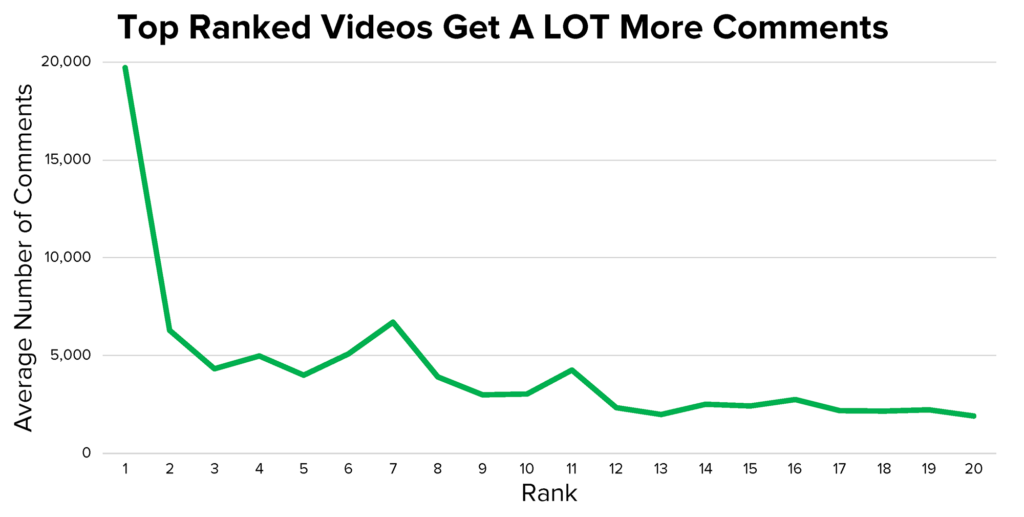
We do see the highest ranked videos having a considerably higher number of comments.
This relationship is unsurprising considering comments are a kind of conversion event downstream from a view, so videos with high a view count will tend to have higher comment counts.
As comment counts increases, so does the average rank performance of a video, at least until a point.
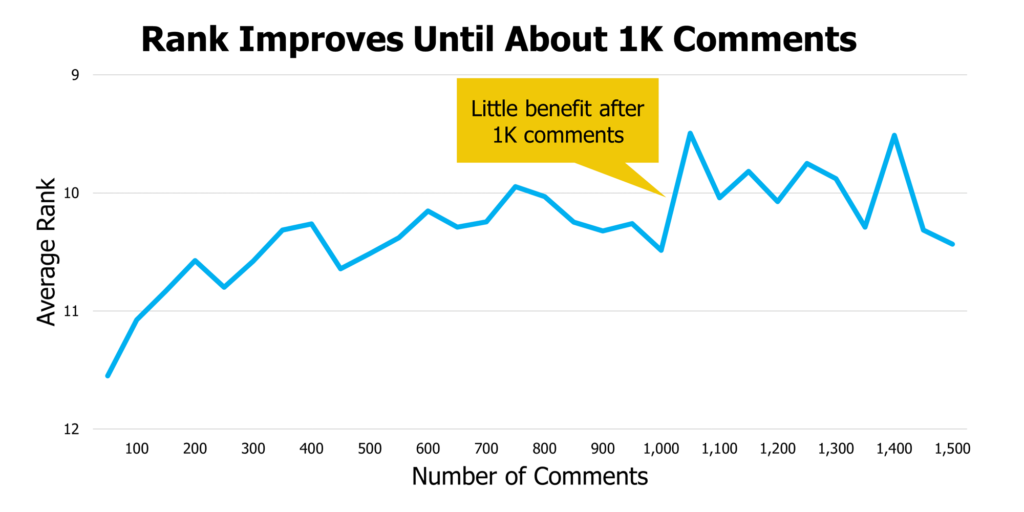
Average rank performance improves as comments increase up until around 1,000 comments, at which time performance tends to flatten out.
Regardless of comments’ weight as a ranking factor, they are a fair indicator of engagement and are a valuable tool for creators to spur engagement and collect qualitative feedback on the sentiment of a video. Your audience’s comments provide value far beyond the raw comment count.
Takeaways
- Focus on improving comment engagement by your viewers.
- Encourage comments by asking a specific question within your video.
- Explicitly ask people to comment.
- If you have an engaged Twitter or Facebook audience, let them know that you are “hanging out” in the comments section of YouTube and invite them to come participate.
- Interact with your audience in comments regularly.
- Develop a community feel that encourages engagement over time.
- Use content from comments to develop your videos, either by featuring comments or using them to source topic ideas for future videos.
- Mine comments for market research on your audience.
YouTube Subscribers
Large channels with high subscriber counts have a substantial advantage in their niche over those with fewer subscribers.
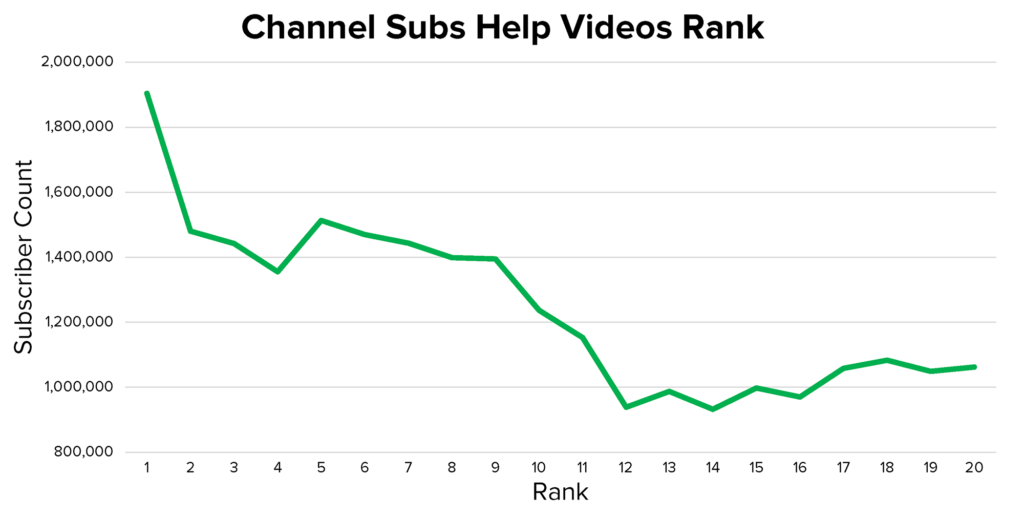
There is a positive relationship between subscriber counts and rankings. While this might be a “channel authority” style signal, it’s important to think of subscriptions as a CRM / distribution list. Channels with larger subscriber counts have a useful tool that drives views through browse features, personalized recommendations, and notifications.
It’s also suggestive of an inherent, engaged audience that can seed videos with a baseline level of views from viewers that are prone to have better retention and longer session durations, driving up watch time relative to channels with less brand affinity. It may also be suggestive of a higher likelihood of binge-watching and playlist usage, which can help seed videos with better cowatch data to power video recommendations.
We see average rank improving at every level of increase in subscribers.
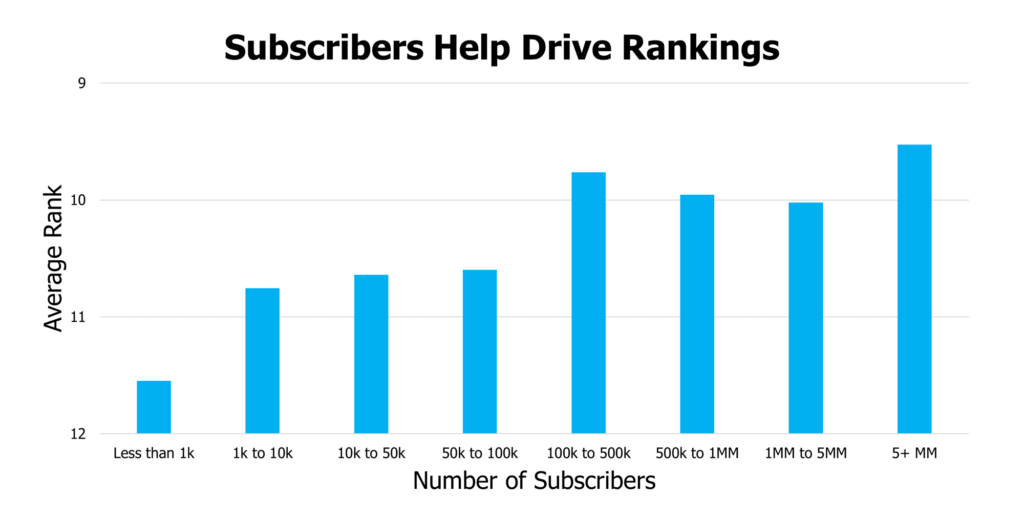
There is a noticeably worse performance of channels with less than 1,000 subscribers. This level is the same benchmark used in the new YouTube Partner Program requirements. The lower visibility at this range may suggest that YouTube could have thresholds that act as a kind of dampener for new, less established channels. A mechanism such as this can help manage spam accounts and could inhibit search visibility until a channel better establishes itself.
There also appears to be four categories of channels based on subscriber counts:
New or Not Enough Data: 0 to 1,000
Established: 1,000 to 100,000
Popular: 100,000 to 5 MM
Highly Popular: 5+ MM
There is a marked ranking improvement as channels move through each of these categories.
Takeaway
- Try to pass 1,000 subscribers as quickly as possible.
- If you’re close to 100k or 5M, make a strong push to cross those thresholds.
- Use CTAs in video and descriptions to improve subscription growth.
- Focus programming and video sequencing around improving subscription growth.
- Keep subject matter tightly focused to encourage subscriptions.
- Review analytics to optimize subscription growth.
Number of Videos on a YouTube Channel
While subscriber counts appear to suggest a channel’s “authority,” the size of the channel, as measured by its number of videos published, does not.
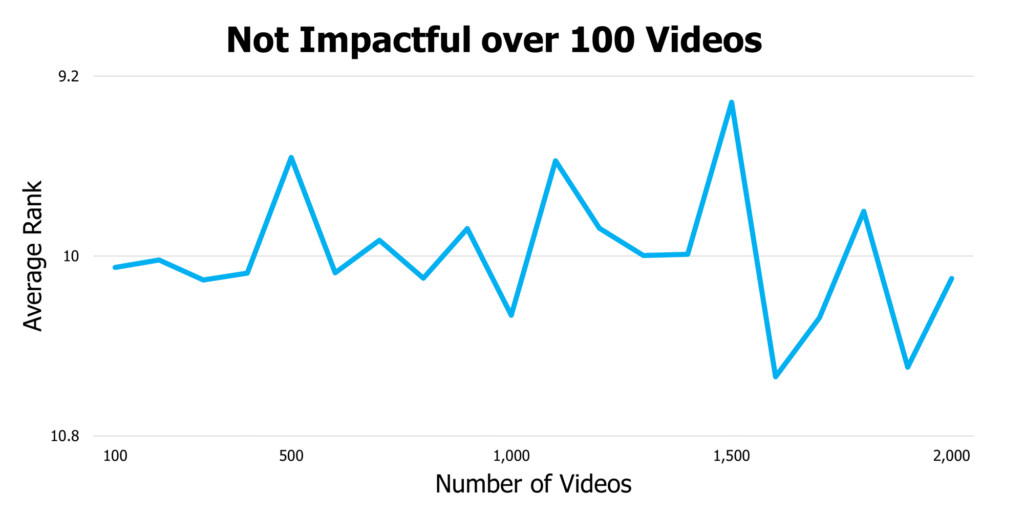
We do not see a strong relationship between the number of videos published by a channel and rank performance.
However, we do see video counts interacting with subscriber counts.
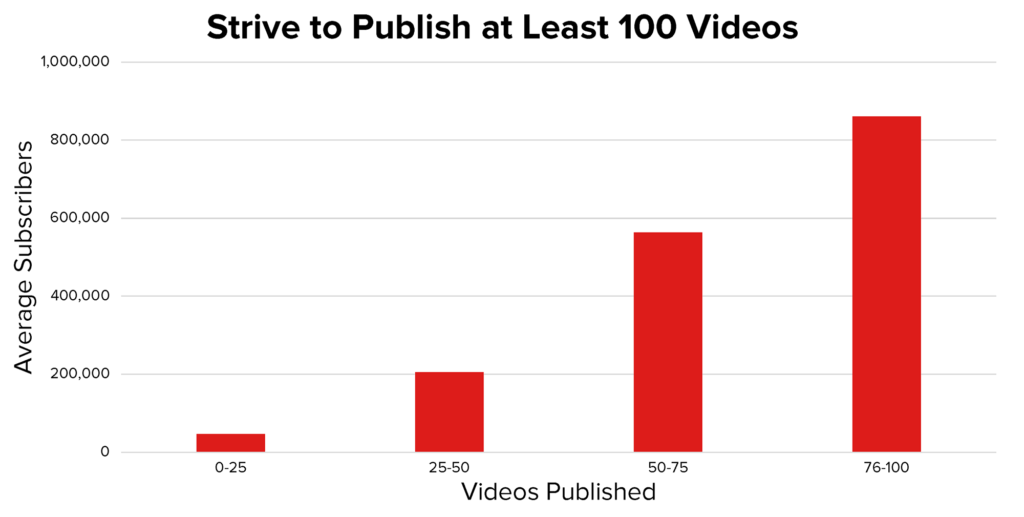
There is a positive relationship between the number of videos published and subscribers for the first 100 videos, at which point it becomes less correlated.
This relationship makes sense, as watchers are less inclined to subscribe to less established channels that publish infrequently. A comprehensive content calendar that builds a robust set of videos in your subject area is an effective means of driving subscriber growth and many other positive benefits.
Takeaways
- Early in a channel’s life, focus on building a substantial body of content.
- Having 100 videos published is an excellent goal to maximize your ability to convert viewers into subscribers.
YouTube Channel Views
Similar to subscriber counts, total channel views appear to be a measure of overall channel authority and trust. We see a positive relationship between channel views and ranking performance.
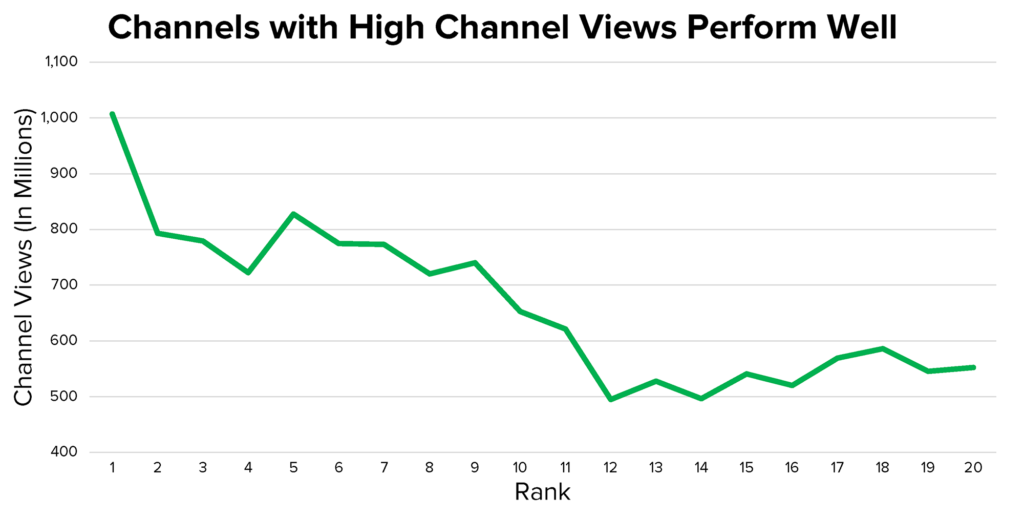
We see a strong improvement in the average rank performance of videos as channel views increase.
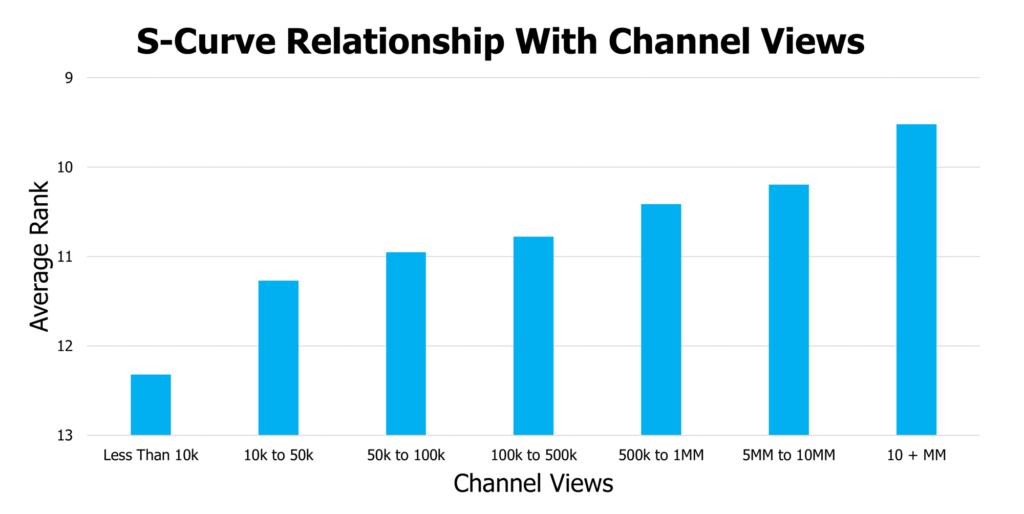
Note the worse performance of channels with less than 10,000 channel views. This range aligns with the benchmark used in the previous YouTube Partner Program requirements. This behavior may suggest that YouTube is using channel views as a minimum threshold in a potential dampener for new and less established channels. While this can help manage spam accounts, it may also inhibit search visibility until a channel has better established itself.
Unlike subscribers, which appear to have four distinct groupings with stepwise variance in performance, the channel view influence has three groups that act a bit like an S-curve with two outlier groups and a mostly linear relationship in the middle.
New or Not Enough Data: 0 to 10,000, marked by a notably worse performance.
Established: 10,000 to 10 MM, have a nearly linear relationship through the middle that shows ranking improvements as channel views improve.
Highly Popular: 10+ MM, marked by a notably better performance
In addition to improving this metric by driving views per video, there is a relationship between the number of videos a channel publishes and its total number of channel views. Increasing your publication rate and having a larger body of content is one useful tool for improving total channel views.
Takeaway
- Prioritize surpassing 10,000 channel views, as being below this level may hinder search performance.
- There is a fairly consistent relationship between channel views and rank performance between 10K and 10M+ views.
- Increase channel publication velocity, so you have a larger number of videos on the channel.
YouTube Video Embeds & Backlinks
YouTube may also use external metrics to determine a video’s popularity and relevance. They’ve suggested at a conference (VidCon) that they use shares, links, and embeds for Trending videos, so we looked into the role links and video embeds played in ranking performance.
In particular, we are looking at the unique domains that either linked to or embedded a video.
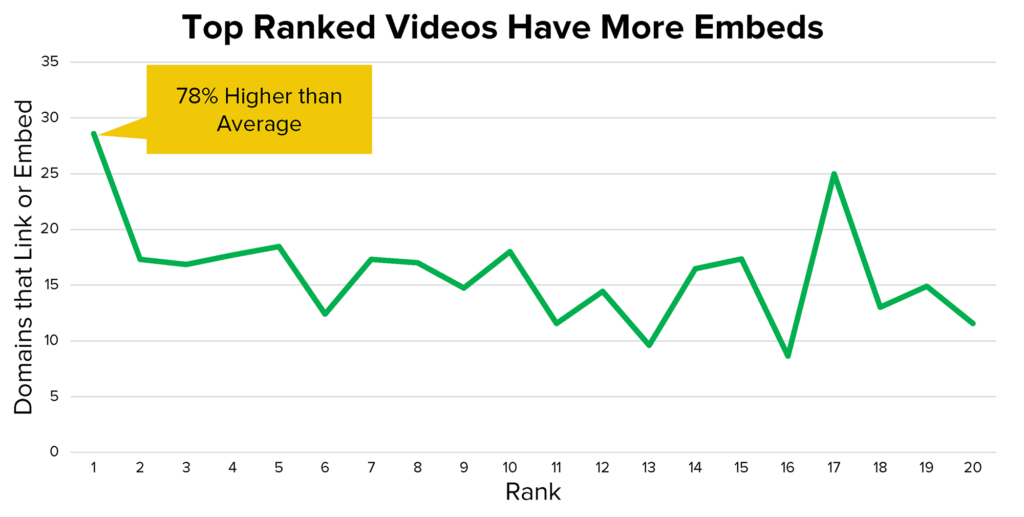
There was a clear, positive relationship between the number of domains that link or embed a video and ranking performance. It is possible that link and embed metrics are a direct input, but its also possible that videos with high external links and embeds receive more views and watch time as a result of that outside-of-YouTube distribution.
It’s also possible that links and embeds are an “outcome” of high view counts, similar to comments and likes. It may be that popular videos on YouTube are more likely to be shared outside of YouTube. Either way, videos that rank well on YouTube have more embeds than average.
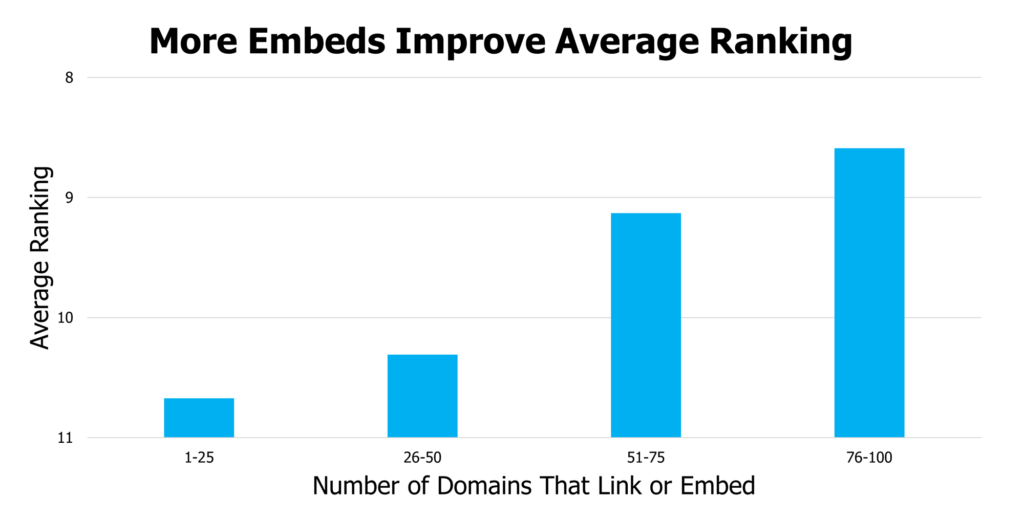
We see an improvement in average rankings as the number of link domains or embeds a video increase. This relationship suggests a high value in promoting a video outside of the YouTube platform.
However, embedded videos tend to have shorter session durations, due to viewers being less likely to watch a second video. (Tempting “Suggested Videos” do not surround embedded videos). To help combat this, you can either focus on driving traffic to the platform or leverage to the playlist parameters on the embed to define a second video that autoplays.
Takeaway
- Publish your videos on your website, either by embedding in content or creating video landing pages on your site.
- Use embed parameters to maximize watch time from your embeds, by allowing related videos or defining the next video.
- Share your videos with partners and pitch your content to bloggers and journalists.
- Tap into the publication cycles of niche publications which may like to use your videos within their content calendar regularly
- Reach out to publications with strong readership in your niche to partner or request what kind of content you could create for them.
- Analyze analytics and optimize content strategy to improve off-platform sharing.
How to Rank Higher on YouTube?
Looking through this data, I found YouTube SEO to be both overly simplistic and excruciatingly complicated.
The core components of how to ranking in Youtube follow many of the basic models leveraged by early search engines, making YouTube SEO seem exceptionally finite. However, YouTube’s algorithm heavily models itself after audience behavior, which is not only mostly invisible to us, but significantly harder to influence.
After the initial optimizations, YouTube SEO starts to become an optimization of the viewing experience, requiring creators to hack behavior as much as they try to hack the algorithm. Lessons from the history of media consumption, TV programming, and advertising become essential as we look for ways to have our audience watch us longer, more frequently, and with higher levels of engagement and satisfaction.
I’d love to hear your thoughts or questions. Feel free to comment below or to reach out on Twitter at @justinrbriggs.
Lastly, a huge thanks to Stephanie Briggs, Dan Shure, and Conor Murphy for the priceless feedback on this post.

I feel like I’ll read this another 10 times, but even after the first read I think this is one of the most valuable pieces of research I’ve read in a long time. Thank you so much for going through all this effort!
Yes, I agree with you, Adam. Justin builds just a perfect plan sheet for any professional Youtuber or amateur like I’m. I will try all these steps in my next video.
I loved this article, THANK YOU! I would have liked more examples to help illustrate key points. Very impactful are examples of do-this-not-this. Otherwise, this is my go-to checklist for YT vids from now on!
Hi Anna, Thanks for the comment! I plan to follow up this post with more actionable advice around each of the areas of optimization (I cut some of that stuff out because it was getting so long). Is there anything in particular you’d like to read more about?
These are really great insights for YouTube SEO. I have been trying to increase watch time, likes, comments for videos and seen minimal improvements but these deeper insights might really help more. Thanks
I am just starting to take YT seriously (after having a channel for about 7 years, and this is immensely helpful! Thanks so much!!
Thank you. WOW for the effort and sharing it with us
They is big difference between yours and other blog who talk about youtube ranking factor, yours are fully satisfied with complete details….. Thanks Justin for the shares
Seriously good article! The amount of research you guys put into this is astounding. Well done!
I don’t understand why i haven’t found this before. Simply amazing.
Hi,
I wondered if you could elaborate on the way you established “Ranking” in this study? Was it the order of the related videos returned on the watch page? Thanks.
Hi David,
Sorry for the late reply. The ranking is the rank position when searching for a keyword in YouTube’s Search. We took a large sample of keywords, searched them, and assigned a rank number (1 first, 2 for 2nd) to each video in the results.
Thanks, it’s really good research about Youtube. we will use these factors to improve our videos ranking.
Thanks for this awesome piece of valuable content. Just added some things to implement in my YouTube Marketing Strategy Checklist. BOOM!